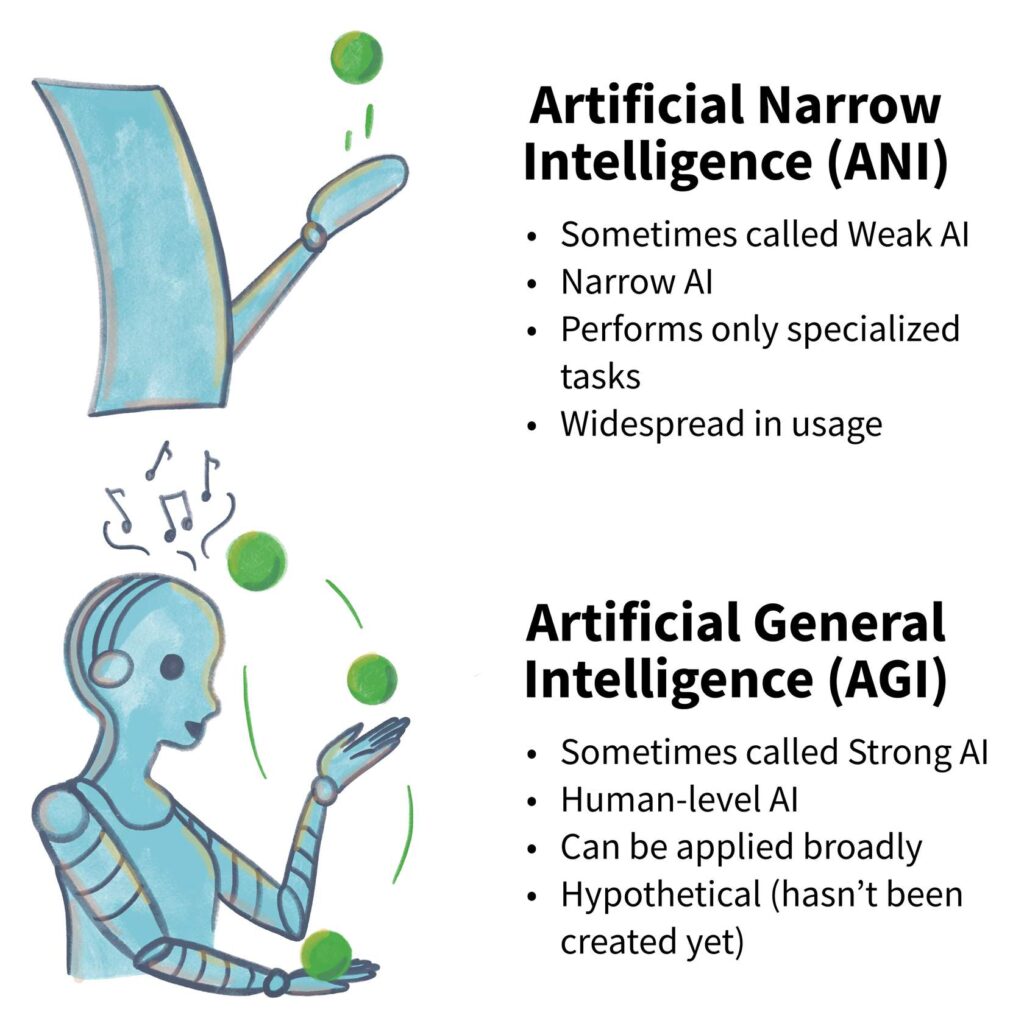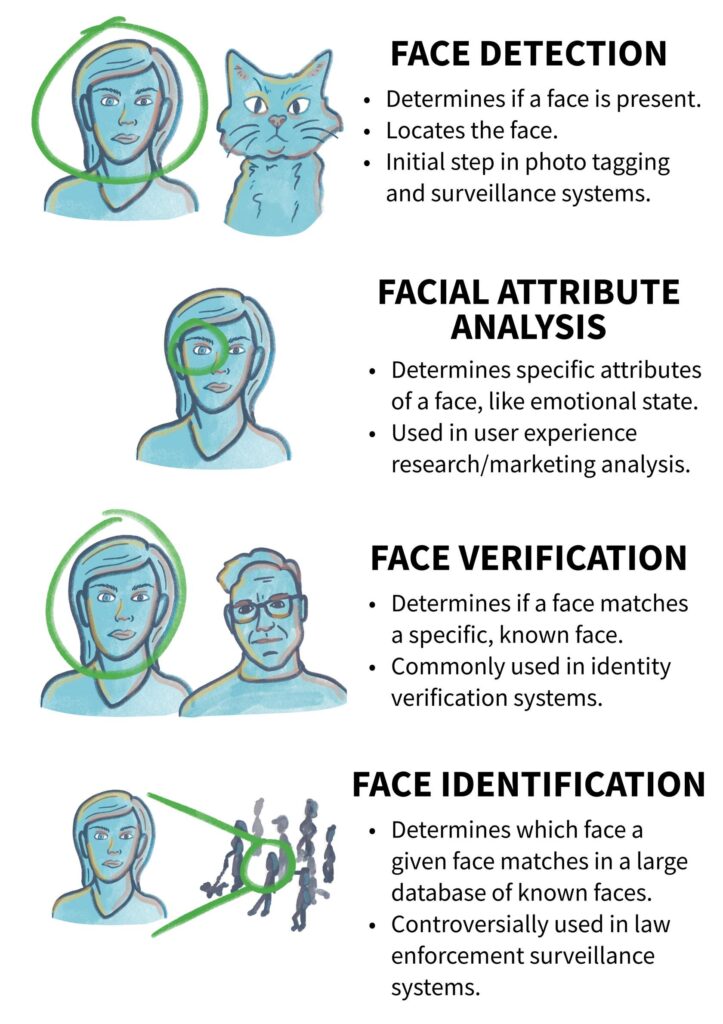Lesson 1: What is AI?
Lesson 1 Learning Objective
By the end of this lesson, you will be able to:
- Define artificial intelligence and distinguish between artificial general intelligence (AGI) and artificial narrow intelligence (ANI).
- Explain the significance of the AI effect and how it influences perceptions of AI advancements.
- Analyze different definitions of AI provided by experts, governments, and AI systems themselves, noting key components and variations.
- Identify various applications of AI in modern life.

It is the science and engineering of making intelligent machines, especially intelligent computer programs.
– John McCarthy, Stanford professor who coined the term in 1955 (also known as the “father” of AI)
Defining AI
Let’s start by coming up with a good definition for artificial intelligence, or AI. It’s surprisingly difficult to define AI, at least to everyone’s satisfaction. Let’s look at a few of the definitions out there.
Click through the tabs below to read definitions of AI according to various sources, including one of the pioneers of AI, the dictionary, the U.S. government, and AI itself – ChatGPT.
Q. What is artificial intelligence?
A. It is the science and engineering of making intelligent machines, especially intelligent computer programs. It is related to the similar task of using computers to understand human intelligence, but AI does not have to confine itself to methods that are biologically observable.
– John McCarthy, Stanford professor who coined the term in 1955 (also known as the “father” of AI)

artificial intelligence: n. The capacity of computers or other machines to exhibit or simulate intelligent behaviour; the field of study concerned with this.
The term ‘artificial intelligence’ means a machine-based system that can, for a given set of human-defined objectives, make predictions, recommendations, or decisions influencing real or virtual environments. Artificial intelligence systems use machine and human-based inputs to –
(A) perceive real and virtual environments;
(B) abstract such perceptions into models through analysis in an automated manner; and
(C) use model inference to formulate options for information or action.
– National Artificial Intelligence Initiative Act of 2020
Artificial Intelligence (AI) refers to the simulation of human intelligence in machines that are designed to think, learn, and make decisions or actions that would typically require human intelligence. This includes tasks like problem-solving, recognizing patterns, understanding natural language, and perception. AI systems can be programmed to perform these tasks through various approaches, including rules-based methods, machine learning, and deep learning. The ultimate goal of AI is to create systems that can perform complex tasks autonomously and adaptively, often improving their performance over time as they gain more experience or data.
– OpenAI. “ChatGPT Response on the Definition of AI.” OpenAI’s ChatGPT, GPT-4, December 3, 2023.
But What Is “Intelligence?”
Did you notice that many of the defintions of artificial intelligence include the world “intelligent” in the definition itself? Herein lies one of the challenges of defining AI – we don’t always mean the same thing when we call something intelligent.
For humans, animals, and computers alike, there are different types and levels of intelligence. It’s very difficult to wrap our arms around all of it. Intelligence in computers can be manifested in their ability to recognize objects in images, translate from one language to another, generate text in response to prompts, and so on. And so the difficulty in precisely defining artificial intelligence is one aspect about it that we’ll all need to embrace.
Knowledge Check 1 of 2
Click the accordions below to expand the question and answer.
Question
Why is it difficult to find a universally accepted definition of artificial intelligence?
a) Not much has been written yet about this relatively new topic
b) There are many different types & levels of intelligent behavior.
Answer
Correct Answer: b) There are many different types & levels of intelligent behavior.
Explanation: AI includes a wide range of subfields and technologies, such as machine learning, deep learning, natural language processing, and computer vision, each with its own set of principles, goals, and applications. This diversity means that AI can be seen and utilized differently across various domains, leading to different interpretations of what AI truly is.
The perception of AI also evolves with technological advancements and integration into society and various industries. As AI becomes more embedded in everyday life, from personal assistants to autonomous vehicles, the understanding of its role and capabilities continues to grow and shift. This ongoing evolution makes it challenging to pin down a static definition that captures the full scope of artificial intelligence.
The AI Effect
The AI effect, sometimes called the AI paradox, says that once a problem thought to require intelligence is solved by a computer, we tend to stop thinking of the problem as requiring “true” intelligence, and, by natural extension, we no longer think of the solution itself as being AI. It’s a classic case of moving the goalposts.
A famous example of the AI Effect involves the case of IBM’s Deep Blue, a pioneering computer system that defeated world chess champion Garry Kasparov 3½ to 2½ in a six-game match. It was the first time a reigning world champion lost a match to a computer under standard chess tournament conditions. In the immediate aftermath, Deep Blue’s victory was widely hailed as a major milestone in artificial intelligence. Soon afterward, however, critics and analysts downplayed Deep Blue’s approach to be nothing more than powerful computation, along with an extensive database of moves to look up.

Knowledge Check 2 of 2
Click the accordions below to expand the question and answer.
Question
True or False: The AI Effect is the phenomenon that once a problem thought to require intelligence is solved by a computer, we tend to stop thinking of the problem as requiring “true” intelligence, and, by natural extension, we no longer think of the solution itself as being AI.
Answer
Correct Answer: True
Explanation: As computers solve problems previously thought to require human intelligence, our perception shifts. What was once deemed an AI achievement becomes just another computational task, leading us to continuously raise the bar for what we consider “true” AI, thus diminishing the recognition of existing AI capabilities as genuinely intelligent.
Weak AI vs. Strong AI
It’s important to distinguish between two forms of AI: weak AI, also called artificial narrow intelligence (ANI), and strong AI, also called artificial general intelligence (AGI).
Click each tab header below to learn about these two distinct levels of AI.
Also called weak AI or narrow AI.
Weak AI encompasses all AI we’ve encountered to date. It refers to any artificial intelligence that has been designed and created to solve a single problem or a very limited set of problems. For example, the recommendation system on an ecommerce website may be very sophisticated and make excellent suggestions to a wide range of potential customers, but in today’s world, it cannot yet drive your car.
Don’t be fooled by the term, though, because such systems have anything but a weak impact on our world. It’s everywhere, and these technologies have dramatically changed many aspects of work, society, and even life itself.
Also called called strong AI or general AI.
AGI is a hypothetical type of AI that, if created, could learn to perform any action that humans are able to perform. Its intelligence, then, would be very broad, and it would be capable of image detection, language processing, reasoning, problem-solving, decision-making across multiple, diverse domains, and more.
Strong AI is hypothetical because it has never been created. Some AI experts believe that it is a long way off, and not all of them believe it’s even possible to develop such a system.

General Purpose AI (GPAI)
The European Union introduced the term General Purpose AI (GPAI) in an amendment to the EU’s AI Act in 2023, formally defining it as an AI model that shows significant generality, capable of performing a wide range of tasks, and can be integrated into various systems or applications. This definition, while aiming to encompass the breadth of AI’s capabilities, includes somewhat vague terms that may evolve with technological advances.
The term seeks to regulate emerging AI technologies like OpenAI’s GPT-4 and Google’s Gemini, considered by most experts to be advanced examples of Artificial Narrow Intelligence (ANI), not Artificial General Intelligence (AGI). However, some researchers see these Large Language Models (LLMs) as early indicators of AGI due to their multimodal and conversational abilities, which surpass the more limited functions of earlier ANI models.
The introduction of GPAI highlights the narrowing gap between AGI and ANI, signifying a significant evolution in AI technology, though its classification may cause confusion between GPAI and AGI.

Examples of AI in Everyday Life
In order to truly know what AI is, we must go beyond definitions and classifications and consider everyday applications of AI. Each one of us interacts with AI in a variety of ways each and every day.
Click on the accordions below to learn about a handful of common AI applications.
Streaming Movie Recommendations
Streaming platforms like Hulu or Netflix use a form of artificial intelligence called a recommendation system (or a recommender) to turn search and viewing history, ratings data, and potentially other demographic variables into a prediction about which shows you’ll most likely watch and enjoy.
Virtual Assistants
Virtual assistants like Amazon’s Alexa or Apple’s Siri use a series of AI components, including voice-to-text speech recognition as well as natural language processing (NLP) algorithms – both natural language understanding (NLU) and natural language generation (NLG) – to “talk” with us and perform a variety of tasks such as finding out the weather, setting a timer in the kitchen, or adding a reminder to our calendar.
Facial Recognition
Apple’s Face ID feature uses the iPhone’s front-facing camera along with thousands of tiny, invisible infrared dots it projects onto the user in order to obtain a 3D image of their face. It then uses technologies from a branch of artificial intelligence called computer vision to determine if the face is the correct one.
Facial recognition can be broken down into four major branches of programs:
1) Face detection determines if a person’s face is present in an image or video, and if so, where the face is located.
2) Facial attribute analysis determines traits of the detected face, such as age, gender, and emotional state.
3) Face verification determines if a given face matches a specific, known face – the type of program used by your smartphone to unlock your screen.
4) Face identification determines which face a given face matches in a database of known faces.

Email Spam Filtering
Your email platform uses a spam filter that employs artificial neural networks, often simply called neural networks, to “learn” what type of words and phrases are commonly included in known spam emails they’re trained on. Neural networks are computational models loosely inspired by the human brain to learn patterns by a process of trial and error. The neural networks of your spam filter then use this training to make predictions as emails of unknown nature are received. They continuously adjust the parameters as you mark whether or not particular messages are spam, helping them keep up with the continuously shifting tactics of spammers seeking to bypass the filters and land a message in your inbox.
Machine Translation
Machine translation is the process of automatically translating from one language to another without the intervention of a human translator. Applications such as Google Translate allow you to enter text or even audio input and receive back the text in a different language of your choice.
These algorithms are not quite perfect, and it’s not uncommon for them to provide output that an expert translator would disagree with. But they have improved dramatically in the past decade. It’s hard to argue against the usefulness of an instant translation, even one in which some nuance and subtleties of speech are “lost in translation.”
Generative AI
Generative AI refers to a subset of artificial intelligence technologies and models that have the capability to generate new content, data, or information that is similar but not identical to the data they were trained on.
Starting on November 30, 2022, ChatGPT by OpenAI revolutionized AI interaction, reaching 100 million users in just two months, setting a record for the fastest adoption of any technology. ChatGPT, powered by a large language model (LLM), generates text responses from user prompts in everyday language, trained on a vast array of internet texts, books, and articles.
Following ChatGPT’s launch, giants like Google and Baidu, alongside open-source initiatives, introduced their own LLMs. Beyond text, generative AI technologies like MidJourney, Stable Diffusion, and OpenAI’s DALL•E also produce images from prompts, with ventures into video creation. These advancements raise critical issues regarding social bias perpetuation and intellectual property rights concerning the original content creators.
Mobile Check Deposits
Our phones utilize optical character recognition (OCR) when we take a photograph of a check in order to deposit in our bank account on our mobile banking app.
Key Terms & Definitions
Let’s review your understanding and retention of some of the most important terms in this lesson. Hover over the cards below to reveal definitions.
AI effect
Also called the AI paradox, the phenomenon that once a problem thought to require intelligence is solved by a computer, we tend to stop thinking of the problem as requiring “true” intelligence, and, by natural extension, we no longer think of the solution itself as being AI.
speech recognition
An AI application that can convert voice inputs into text, enabling virtual assistants to process and respond to human language.
artificial general intelligence (AGI)
A hypothetical AI, also referred to as strong AI or general AI, capable of performing any human task, with broad intelligence across various domains.
artificial narrow intelligence (ANI)
Also known as weak AI or narrow AI, an AI that’s designed to perform specific or limited tasks that typically require human intelligence. Contrast with artificial general intelligence (AGI) which is capable of much broader cognitive abilities.
general purpose AI (GPAI)
Defined in an amendment to the EU’s AI Act to be an “AI model, including when trained with a large amount of data using self-supervision at scale, that displays significant generality and is capable to competently perform a wide range of distinct tasks regardless of the way the model is placed on the market and that can be integrated into a variety of downstream systems or applications.”
recommendation system
Also known as a recommender, an AI application that provides suggestions for users, such as movies or products, based on their preferences and history.
natural language processing (NLP)
An AI technology that leverages machine learning to process and generate human language, enabling systems to interact with humans via text or voice exchanges.
computer vision
A field of AI that enables machines to interpret and make decisions based on visual data, mimicking human visual processing.
face detection
A type of facial recognition that attempts to determine if a person’s face is present in an image or video, and if so, where the face is located.
facial attribute analysis
A type of facial recognition application that is designed to determine traits of the detected face, such as age, gender, and emotional state.
face verification
A type of facial recognition with a goal to determine if a given face matches a specific, known face – the type of program used by your smartphone to unlock your screen.
face identification
A type of facial recognition concerned with determining which face a given face matches in a potentially large database of known faces.
machine translation
An AI technology that seeks to automatically translate from one language to another without the intervention of a human translator, used in applications like Google Translate.
generative AI
AI technologies that can generate content, like text, images, or videos, from user prompts, such as ChatGPT, DALL•E, and Stable Diffusion, raising questions about algorithmic biases and intellectual property rights.
optical character recognition (OCR)
An AI application that can convert images of printed or hand-written text, such as photographs of checks or automobile license plates, into machine-encoded text.
Further Learning
If you’d like to further your learning of the topics covered in this lesson, here are some resources for you to explore:
- Research Study: “Public Awareness of Artificial Intelligence in Everyday Activities,” Pew Research Center, Feb 15, 2023 https://www.pewresearch.org/science/2023/02/15/public-awareness-of-artificial-intelligence-in-everyday-activities/. Accessed February 28, 2024
- YouTube Video: “We’re already using AI more than we realize,” Vox.com, Feb 28. 2024 https://www.youtube.com/watch?v=YsZ-lx_3eoM
- Academic Report: “The One Hundred Year Study of Artificial Intelligence (AI100).” Stanford University, 2021, ai100.stanford.edu.